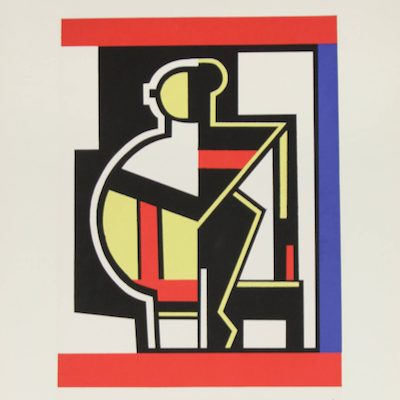
Details
Artist
Styles
Etching and aquatint in colours, on BFK Rives paper, with full margins. - This work is from the UNITÉ book, which began to be printed in 1963 and ended on October 15, 1965 in Paris. - I. 41.5 x 31.5 cm (16 3/8 x 12 3/8 in.) - S. 57 x 45.2 cm (22 1/2 x 17 3/4 in.) - Signed and numbered in pencil, from the edition of 130 pc + 30 in Roman numerals, published by Atelier Crommelynck, Paris // Le Corbusier’s Unité 11 (1963-1965) is a limited-edition etching and aquatint printed on BFK Rives paper, showcasing a vibrant composition divided into four colored quadrants—yellow, red, blue, and green. Each quadrant contains abstract forms and lines that intersect, creating a dynamic sense of motion. The left side of the artwork is dominated by a yellow ladder-like form, while the bottom right features organic, gestural shapes resembling hands. The use of bold color blocks contrasted with intricate line work reflects Le Corbusier’s exploration of architectural and human elements, blending structural and fluid forms. The overall composition suggests a tension between order and spontaneity, characteristic of Le Corbusier’s work.
Unité 11, 1963-1965
form
Medium
Size
57 x 45.2 cm
- Inches
- Centimeters
Edition
Price
- USD
- EUR
- GBP
Details
Artist
Styles
Etching and aquatint in colours, on BFK Rives paper, with full margins. - This work is from the UNITÉ book, which began to be printed in 1963 and ended on October 15, 1965 in Paris. - I. 41.5 x 31.5 cm (16 3/8 x 12 3/8 in.) - S. 57 x 45.2 cm (22 1/2 x 17 3/4 in.) - Signed and numbered in pencil, from the edition of 130 pc + 30 in Roman numerals, published by Atelier Crommelynck, Paris // Le Corbusier’s Unité 11 (1963-1965) is a limited-edition etching and aquatint printed on BFK Rives paper, showcasing a vibrant composition divided into four colored quadrants—yellow, red, blue, and green. Each quadrant contains abstract forms and lines that intersect, creating a dynamic sense of motion. The left side of the artwork is dominated by a yellow ladder-like form, while the bottom right features organic, gestural shapes resembling hands. The use of bold color blocks contrasted with intricate line work reflects Le Corbusier’s exploration of architectural and human elements, blending structural and fluid forms. The overall composition suggests a tension between order and spontaneity, characteristic of Le Corbusier’s work.
- Recently Added
- Price (low-high )
- Price (high-low )
- Year (low-high )
- Year (high-low )
What is Cubism?
Cubism is an art movement that aimed to depict multiple perspectives of objects or figures within a single picture. Artists Georges Braque and Pablo Picasso pioneered this style around 1907. The name Cubism emerged from their use of geometric shapes and outlines that often resembled cubes, breaking objects down into abstracted forms.





























